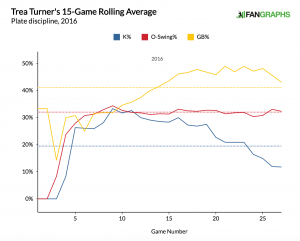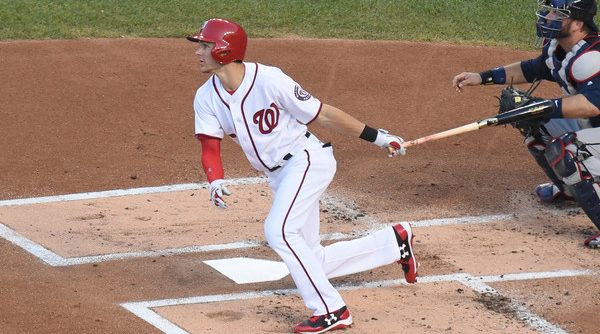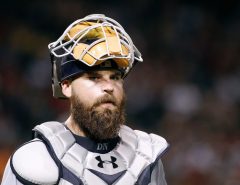Andrew laid out a solid case for why Trea Turner could live up to the lofty expectations Nationals’ fans have set for him. Everyone is certainly pulling for him to be the star he has looked like so far this season. But baseball is hard, especially for rookies. The history of the league is littered with rookies who made big impacts right off the bat, only to come crashing back to earth after the league made a few adjustments. The honeymoon phase is starting to wind down on Turner, and he’s going to have to prove he can adjust to the league’s approach to him.
As Andrew alluded to, Turner’s biggest bugaboo is his propensity for the strikeout. Sure, he’s dynamic on the base paths and has been able to maintain a blend of power and average with the bat. The league has noticed, though, and is adjusting to Turner’s early success. Turner has so far been able to do that, but the surface numbers may not paint the whole picture.
Similar to most rookies, Turner got a heavy dose of fastballs early in his big league at bats this season. In April and June, Turner saw over 70% fastballs from opposing pitchers who wanted to test him early with the hard stuff. Once Turner proved he could handle big league velocity, the approach quickly shifted. In July and so far in August, Turner has seen only 58% fastballs and has seen a heavy dose of off speed pitches.
It’s a smart change in game plan. Turner has hit over .365 against fastballs but only .091 in at-bats ending in a changeup and .083 in at-bats finished with a curveball. Turner has had a difficult time simply making contact with major league-caliber off speed pitches, whiffing on 41% of curveballs he has swung at and 48% of changeups. It hasn’t affected Turner’s numbers yet, but that’s a difficult mix to keep up.
While facing a higher mix of pitches he can’t hit, Turner has not only continued to hit but has actually cut down on his strikeout rate. On the one hand, that’s obviously exciting. The league adjusted to Turner and he wasn’t fazed by the new approach. On the other hand, the new approach to Turner has had an underlying effect.

The above graph shows the 15-day rolling average of strikeout percentage (in blue), swings at pitches out of the zone (red), and ground ball rate (yellow). The most obvious drop off is in that strikeout rate, from a high of nearly 35% early on in the season to just over 10% over his last 15 games. Usually, a drop in strikeout rate is driven by improved plate discipline. However, Turner hasn’t cut back on swings out of the zone. Instead, he’s been making more contact on his swings but hitting more balls on ground. Of course, when routine ground balls to the second baseman can be turned into hits by Turner, ground balls aren’t a bad thing. But ground balls off of pitches out of the strike zone are usually the most weakly hit balls and aren’t a sustainable recipe for success. The league has adjusted to Turner but really, Turner hasn’t made any adjustments himself.
The true test of any rookie hitter comes when opposing pitchers finally find a successful plan of attack. While the results aren’t there just yet for the league’s new approach to Turner, he has yet to prove he can handle off speed pitching or lay off of pitches out of the zone. At some point, something has to give. If Turner does start to stumble in the next couple of weeks, it will because of his struggles against off speed pitches. Of course, Turner has a long track record of success in college and the minor leagues made by possible by his ability to adjust. Hopefully he can repeat the feat in the big leagues.
Tags: Nationals, Nats, Trea Turner, Washington Nationals




Leave a Reply